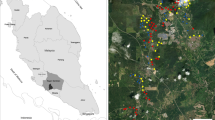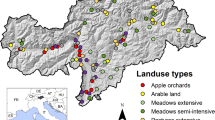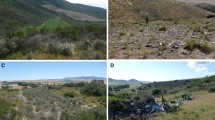Abstract
Agroforestry practices, such as Shaded Coffee and Homegardens, may provide habitat for forest butterflies and contribute to their conservation in fragmented agricultural landscapes. To determine the influence of agroforestry practices in an agricultural mosaic, the distribution of fruit-feeding butterflies was studied using a systematic approach that compared butterfly species richness in six land-use practices (Eucalyptus [Eucalyptus spp.], Shaded Coffee, Homegardens, Secondary Growth, Pastures, and monocultures of Cassava [Manihot esculenta] and Sugarcane [Saccharum officinarum]), and in natural habitat (secondary Forest Edge and Interior) in two study areas (agricultural landscapes). In each study area, Van Someren-Rydon butterfly traps were placed as a grid every 150 m, creating quadrants of 2.2 and 2.4 km2 that encompassed the different land-use practices. Land-use, plot area, number of traps and distance to the forest were set as covariates to compare species richness values. Butterfly species composition was compared using linear discriminant analysis (LDA). With the exception of Pastures, Cassava and Sugarcane, significant differences were not identified between the rest of the agricultural land-use practices and the forest habitats (edge and interior). The species composition in the agricultural practices was however, different to that found in forest habitats. Overall, Shaded Coffee practices that represent long-term mixed tree and crop stands have a better potential of conserving forest butterfly species compared to monoculture practices.





Similar content being viewed by others
References
Barlow J, Araujo IS, Overal WL, Gardner TA, Da Silva Mendes F, Lake IR, Peres CA (2009) Diversity and composition of fruit feeding butterflies in tropical Eucalyptus plantations. Biodivers Conserv 17:1089–1104
Bhagwat SA, Willis KJ, Birks HJB, Whittaker RJ (2008) Agroforestry: a refuge for tropical biodiversity? Trends Ecol Evol 23:261–267
Bobo KS, Waltert M, Sainge NM, Njokagbor J, Fermon H, Muhlenberg M (2006) From forest to farmland: species richness patterns of trees and understorey plants along a gradient of forest conversion in southwestern Cameroon. Biodivers Conserv 15:4097–4117
Bos MM, Steffan-Dewenter I, Tscharntke T (2007) Shade tree management affects fruit abortion, insect pests and pathogens of cacao. Agric Ecosyst Environ 120:201–205
Brown KS, Freitas AVL (2000) Atlantic forest butterflies: Indicators for landscape conservation. Biotropica 32:934–956
Burns R, Burns R (2009) Discriminant analysis. Business research methods and statistics using SPSS. SAGE Publications, London
Buschhorn P (2010) Species diversity and feeding preferences of butterflies along a rainfall gradient in Bolivia. Dissertation. The University of Göttingen. http://issuu.com/patrickbuschhorn/docs/memoire-patrickbuschhorn. Accessed 10 June 2013
Colwell RK (2013) EstimateS: Statistical estimation of species richness and shared species from samples. Version 9. http://purl.oclc.org/estimates. Accessed 12 June 2013
Conradt L, Roper TJ, Thomas CD (2001) Dispersal behavior of individuals in metapopulations of two British butterflies. Oikos 95:416–424
Cullen L, Alger K, Rambaldi DM (2005) Land reform and biodiversity conservation in Brazil in the 1990s: conflict and the articulation of mutual interests. Conserv Biol 19:747–755
Cullen L, Schmink M, Padua CV, Morato MIR (2001) Agroforestry benefit zones: a tool for the conservation and management of Atlantic forest fragments, Sao Paulo, Brazil. Nat Areas J 21:346–356
D’Abrera BL (1984) Butterflies of South America. Hill House, Victoria
Dennis RL, Shreeve TG (1988) Hostpant-habitat structure and the evolution of butterfly mate-locating behavior. Zool J Linnean Soc 94:301–318
DeVries PJ, Walla TR (2001) Species diversity and community structure in neotropical fruit-feeding butterflies. Biol J Linnean Soc 74:1–15
DeVries PJ (1987) The butterflies of Costa Rica and their natural history. Princeton University Press, New Jersey, p 288
Dolia J, Devy MS, Aravind NA, Kumar A (2008) Adult butterfly communities in coffee plantations around a protected area in the Western Ghats, India. Anim Conserv 11:26–34
Dunnett CW (1980) Pairwise multiple comparisons in the unequal variance case. Biomed 37:182
Egeskog A, Berndes G, Freitas F, Gustafsson S, Sparovek G (2011) Integrating bioenergy and food production—a case study of combined ethanol and dairy production in Pontal Brazil. Energy Sustain Dev 15(1):8–16
Emery ED, Brown KS, Pinheiro CEG (2006) The butterflies (Lepidoptera, Papilionoidea) of the Distrito Federal, Brazil. Rev Brasileira De Entomol 50:85–92
ESRI (2009) ARcGIS desktop: Release 10. Environmental Systems Research Institute, Redlands
Estrada A, Cammarano P, Coates-Estrada R (2000) Bird species richness in vegetation fences and in strips of residual rain forest vegetation at Los Tuxtlas, Mexico. Biodiv Conserv 9:1399–1416
Estrada A, Coates-Estrada R, Meritt D Jr (1993) Bat species richness and abundance in tropical rain forest fragments and in agricultural habitats at Los Tuxtlas. Mexico Ecogr 16(4):309–318
Fleishman E, Murphy DD (2009) A realistic assessment of the indicator potential of butterflies and Other Charismatic Taxonomic Groups. Conserv Biol 23:1109–1116
Freitas FLM, Sparovek G (2008) Sugarcane expansion near to agrarian reform settlements: a case study of Pontal, Brazil. http://www.docstoc.com/docs/3824542/sugarcane-expansion-near-to-agrarian-reform-settlements-a-case-study. Accessed 05 June 2012
Harvey CA, Villalobos JAG (2007) Agroforestry systems conserve species-rich but modified assemblages of tropical birds and bats. Biodiv Conserv 16:2257–2292
Harvey CA, Gonzalez J, Somarriba E (2006) Dung beetle and terrestrial mammal diversity in forests, indigenous agroforestry systems and plantain monocultures in Talamanca, Costa Rica. Biodiv Conserv 15:555–585
Harvey DJ (1991) Higher classification of the Nymphalidae, Appendix B, p. 255–268. In: Nijhout HF (ed) The development and evolution of butterfly wing patterns. Smithsonian Institution Press, Washington, p 318
Izenman AJ (2008) Modern multivariate statistical technique. Springer, New York, pp 237–280
Janz N, Nylin S, Wahlberg N (2006) Diversity begets diversity: host expansions and the diversification of plant-feeding insects. Evol Biol 6:4
Jose S (2009) Agroforestry for ecosystem services and environmental benefits: an overview. Agrofor sys 76(1):1–10
Keppel G (1991) Design and analysis: a researcher’s handbook, 3rd edn. Prentice-Hall, Inc, Englewood Cliffs
Klein AM, Steffan-Dewenter I, Buchori D, Tscharntke T (2002) Effects of land-use intensity in tropical agroforestry systems on coffee flower-visiting and trap-nesting bees and wasps. Conserv Biol 16:1003–1014
Kremen C (1992) Assessing the indicator properties of species assemblages for natural areas monitoring. Ecol Appl 2:203–217
Krenn HW (2008) Feeding behaviours of neotropical butterflies (Lepidoptera, Papilionoidea). Denisia, zugleich Kataloge der oberösterreichischen Landesmuseen Neue Serie 88:295–304
Kruess A, Tscharntke T (2002) Grazing intensity and the diversity of grasshoppers, butterflies, and trap-nesting bees and wasps. Conserv Biol 16:1570–1580
Laurance WF, Lovejoy TE, Vasconcelos HL, Bruna EM, Didham RK, Stouffer PC, Gascon C, Bierregaard RO, Laurance SG, Sampaio E (2002) Ecosystem decay of Amazonian forest fragments: A 22-year investigation. Conserv Biol 16:605–618
Lima JF, Gomes HB, Cullen L Jr, Beltrame TP, Moscogliato AV, Campos NR (2007) Café con Floresta: Criando suficiência alimentar e biodiversidade ecológica. In: Fundacão Cargil. Manejo ambiental e restauracão de áreas degradadas, São Paulo, 01:77–107
Marden JH, Chai P (1991) Aerial predation and butterfly design: how palatability, mimicry and the need for evasive flight constrain mass allocation. Am Nat 138(1):15–36
Marin L, Leon-Cortes JL, Stefanescu C (2009) The effect of an agro-pasture landscape on diversity and migration patterns of frugivorous butterflies in Chiapas, Mexico. Biodiv Conserv 18:919–934
Marin MA, PeňaC Freitas AV, Wahleberg N, Uribe SI (2011) From the phylogeny of the Satyrinae butterflies to the systematics of Euptychiina (Lepidoptera:Nymphalidae): history, progress and prospects. Neotrop Entomol 40(1):1–13
McNeely JA, Schroth G (2006) Agroforestry and biodiversity conservation—traditional practices, present dynamics, and lessons for the future. Biodiv Conserv 15:549–554
Menegario C (2006) Quintais agroflorestais como ilhas de biodiversidade. Botucatu, São Paulo
Mielke OHH, Casagrande MM (1997) Papilionoidea and Hesperioidea (Lepidoptera) from the Morro do Diabo State Park, Teodoro Sampaio, São Paulo, Brazil. Rev Brasileira De Zool 14:967–1001
Nair PKR (1991) State-of-the-art of agroforestry systems. Ecol Manag 45:5–29
PEMD (2006) Parque Estadual do Morro do Diabo: plano de manejo/[coordenador editorial Helder Henrique de Faria]. Editoria Viena, São Paulo
Perfecto I, Rice RA, Greenberg R, VanderVoort ME (1996) Shade Coffee: a disappearing refuge for biodiversity. Bioscience 46:598–608
Perfecto I, Vandermeer J (1996) Microclimate changes and the indirect loss of ant diversity in a tropical agroecosystem. Oecologia 108:577–582
Perfecto I, Mas A, Dietsch T, Vandermeer J (2003) Conservation of biodiversity in coffee agroecosystems: A tri-taxa comparison in southern Mexico. Biodiv Conserv 12:1239–1252
Perfecto I, Vandermeer J, Mas A, Pinto LS (2005) Biodiversity, yield, and Shade Coffee certification. Ecol Econ 54:435–446
Perfecto I, Vandermeer J (2008) Spatial pattern and ecological process in the coffee agroforestry system. Ecology 89:915–920
Pettirossi N (2009) Richness, abundane, and species composition of frugivorous butterflies (Lepidoptera, Nymphalidae) at Mata de Santa Genebra Forest Reserve, Campinas, Brazil. Boletim do Museu de Biol Mello Leitao 25:13–29
Philpott SM, Arendt WJ, Armbrecht I, Bicier P, Diestch TV, Gordon C, Greenberg R, Perfecto I, Reynoso-Santos R, Soto-Pinto L, Tejeda-Cruz C, Williams-Linera G, Valenzuela J, Zolotoff M (2008) Biodiversity loss in Latin American coffee landscapes: review of the evidence on ants, birds, and trees. Conserv Biol 22(5):1093–1105
Pozo A, Luis-Martinez A, Lorente-Bousquets JL, Salas-Suarez N, Maya-Martinez A, Vargas-Fernandez I, Warren AD (2008) Seasonality and phenology of the butterflies (Lepidoptera: Papilionoidea and Hesperioidea) of Mexico’s Calakmul Region. Florida Entomol 91:407–422
Ranta P, Blom T, Niemelä J, Joensuu E, Siitonen M (1998) The fragmented Atlantic Rain Forest of Brazil: size, shape and distribution of forest fragments. Biodiv and Conserv 7:385–403
Ricketts TH (2001) The matrix matters: effective isolation in fragmented landscapes. Am Nat 158(1):87–99
SAS Institute Inc. (2011) SAS® 9.3. SAS Institute Inc, Cary
Scales BR, Marsden SJ (2008) Biodiversity in small-scale tropical agroforest: a review of species richness and abundance shifts and the factors influencing them. Environ Conserv 35(2):160–172
Schroth G, Fonseca GAB, Harvey CA, Gascon C, Vasconcelos HL, Izac AMN (2004) Agroforestry and biodiversity conservation in tropical landscapes. Island Press, Washington, DC
Schulze CH, Fiedler K (1998) Habitat preference and flight activity of Morphinae butterflies in a Bornean rainforest, with a note on sound production by adult Zeuxidia (Lepidoptera: Nymphalidae). Malayan Nat J 52:163–176
Schulze CH, Waltert M, Kessler PJA, Pitopang R, Shahabuddin, Veddeler D, Muhlenberg M, Gradstein SR, Leuschner C, Steffan-Dewenter I, Tscharntke T (2004) Biodiversity indicator groups of tropical land-use systems: comparing plants, birds, and insects. Ecol Appl 14:1321–1333
Scott JA (1974) Mate-locating behavior in butterflies. Am Midland Nat 91:103–117
Sundufu A, Dumbuya R (2008) Habitat preferences of butterflies in the Bumbuna forest, Northern Sierra Leone. J Insect Sci 8:1–17
Taylor PD, Fahrig L, Henein K, Merriam G (1993) Connectivity is a vital element of landscape structure. Oikos 68:571–572
Tobar Lopez D, Ibrahim M, Casasola F (2007) Butterfly diversity in an agricultural landscape in the Central Pacific region of Costa Rica. Agrofor Am 4:58–65
Tscharntke T, Sekercioglu CH, Dietsch TV, Sodhi NS, Hoehn P, Tylianakis JM (2008) Landscape constraints on functional diversity of birds and insects in tropical agroecosystems. Ecology 89:944–951
Uehara-Prado M, Brown KS, Freitas AVL (2007) Species richness, composition and abundance of fruit-feeding butterflies in the Brazilian Atlantic Forest: comparison between a fragmented and a continuous landscape. Glob Ecol Biogeogr 16:43–54
Uehara-Prado M, Freitas AVL, Francini RB, Brown KS Jr (2004) Guia das borboletas frugívoras da Reserva Estadual do Morro Grande e região de Caucaia do Alto, Cotia (São Paulo). Biota Neotrop 4:1–25
Valladares-Padua C, Padua SM, Cullen L Jr (2002) Within and surrounding the Morro do Diabo State Park: biological value, conflicts, mitigation and sustainable development alternatives. Environ Sci Policy 5:69–78
Van Dyck H, Baguette M (2005) Dispersal behavior in fragmented landscapes: routine or special movements? Basic Appl Ecol 6:535–545
Veddeler D, Schulze CH, Steffan-Dewenter I, Buchoori D, Tscharntke T (2005) The contributions of tropical secondary forest fragments to the conservation of fruit-feeding butterflies: effects of isolation and age. Biodiv Conserv 14(14):3577–3592
Wezel A, Bender S (2003) Plant species diversity of Homegardens of Cuba and its significance for household food supply. Agrofor Syst 57:37–47
Wiens JA, Hayward GD, Holthausen RS, Wisdom MJ (2008) Using surrogate species and groups for conservation planning and management. Biosci 58:241–252
Williams-Guillén K, McCann C, Martinez Sanchez JC, Koontz F (2006) Resource availability and habitat use by mantled howling monkeys in a Nicaraguan coffee plantation: can agroforests serve as core habitat for a forest mammal? Anim Conserv 9:331–338
Acknowledgments
The funding sources for the study include the School of Forest Resources and Conservation, the Tropical Conservation and Development Program, and the Working Forest in the Tropics Program, all at the University of Florida; the South Eastern Alliance of Graduate Students and Professoriate (SEAGEP), and the National Security Education Program Boren Fellowship. We are also grateful to the Institute for Ecological Research (IPE), Brazil, and its staff, well as to the Science Partners in Inquiry-based Collaborative Education GK-12 program, and the School of Agribusiness and Agriscience at Middle Tennessee State University. We would also like to acknowledge Purdue University’s statistical consulting services for their assistance with the statistical analyses.
Author information
Authors and Affiliations
Corresponding author
Rights and permissions
About this article
Cite this article
Francesconi, W., Nair, P.K.R., Levey, D.J. et al. Butterfly distribution in fragmented landscapes containing agroforestry practices in Southeastern Brazil. Agroforest Syst 87, 1321–1338 (2013). https://doi.org/10.1007/s10457-013-9640-y
Received:
Accepted:
Published:
Issue Date:
DOI: https://doi.org/10.1007/s10457-013-9640-y




